
Following-up on yesterday’s short post questioning the long-term safety and stability of Australia’s banking system, The Australian’s Adam Creighton published an detailed article arguing that Australia’s banks have become far too-big-to-fail, placing taxpayers and the economy at risk of a future financial crisis:
LABOR leader Ben Chifley’s quixotic 1947 plan to nationalise Australia’s banks ended his political career, but in a perverse way his dream came true.
Australia’s big four banks have become so enormous and so indebted that they are public when they make losses and private companies when they don’t, whatever the government or law may say…
Standard & Poor’s, a ratings agency, gives Australia’s biggest four banks a AA rating explicitly because taxpayers will provide “extraordinary support” to their creditors in any crisis, an implicit guarantee worth more than one-quarter of the four’s annual profits.
Since 1995, the big four Australian banks’ assets, reflecting a global trend, have ballooned from 94 per cent of Australia’s national income to $2.86 trillion, or 190 per cent…
“With the exception of the UK and Ireland, no other national banking system in major economies has experienced a comparable expansion of banks’ importance,” they add.
…discredited global bank regulations – first rolled out in the late 1980s and known as the Basel rules – allowed banks’ capital ratios to fall to dangerous and historic lows.
Deposits are less than 65 per cent of banks’ borrowings, the rest short and long-term borrowing from other foreign and Australian banks – an interconnectedness that increases the risk of financial contagion…
The big Australian banks’ huge profits are as much a symptom of sickness as financial health. Any business that leverages itself massively will generate a high return on its sliver of equity, as the big four routinely do…
A quick glance at the key statistics supports the arguments put forward that Australia’s banks are undercapitalised and have become way too big.
First, as noted yesterday, the amount of capital held against total credit exposures ranges from only 2.7% (Westpac) to 4.3% (NAB), with capital held against mortgages at around half that level:
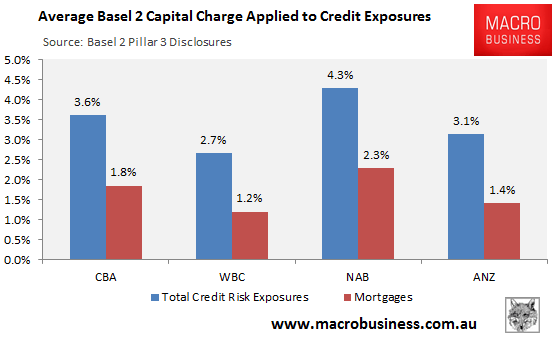
Second, the assets (mostly loans) of the banking system have exploded from around 40% of GDP in the late-1970s to just under 200% of GDP currently:
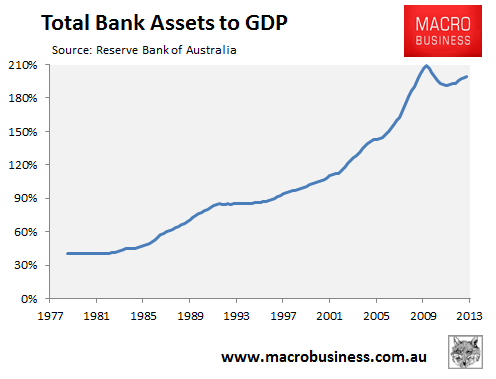
Third, the Finance and Insurance sector, which is dominated by banking, has grown at more than twice the pace of the rest of the economy since deregulation in the mid-1980s:
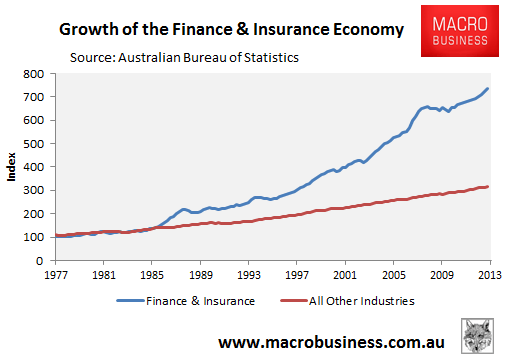
With most of this growth capitalised into Australian house prices, which decoupled from rents from the late-1980s:
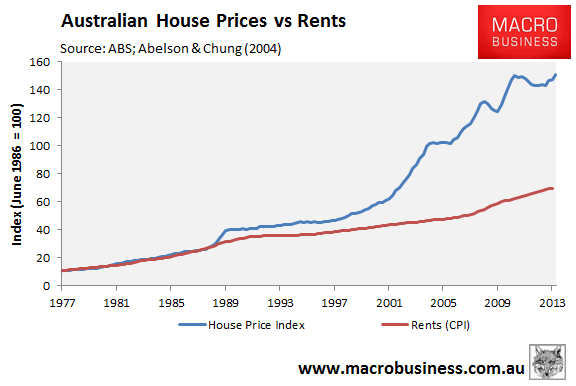
Finally, offshore borrowings have exploded from around 8% of GDP in the late-1980s to over 40% of GDP currently, which has helped to fund the explosion in banking assets (mostly loans):
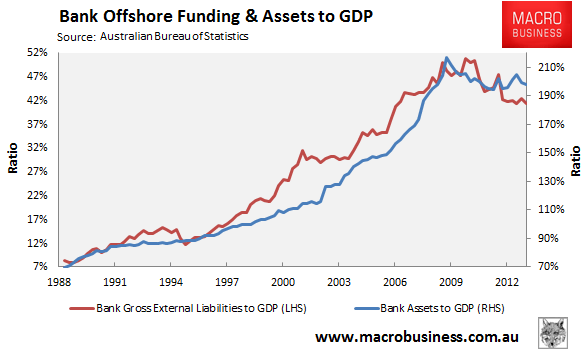
Think about these facts the next time you hear an Australian bank executive or the Bankers’ Association complain about “tough new banking regulations” or new insurance levies imposed on deposits/funding. It is the taxpayer’s implicit support and lax global banking regulations that have enabled them to grow into behemoths, extracting great profits in the process, and it is the taxpayer that will be on the hook were a financial crisis ever to visit our shores.

